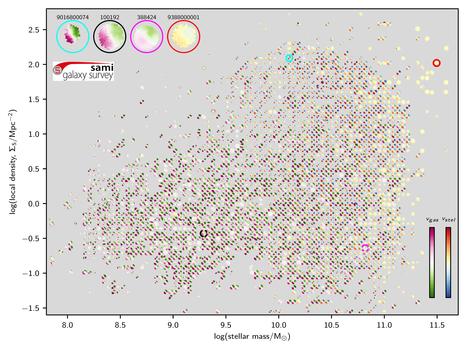About the SAMI Galaxy Survey
The SAMI Galaxy Survey began in March 2013, with the intention of creating a large survey of 3000 galaxies across a large range of environment. The key science goals of the SAMI Survey are to answer the following questions:
- What is the physical role of environment in galaxy evolution?
- What is the relationship between stellar mass growth and angular momentum development in galaxies?
- How does gas get into and out of galaxies, and how does this drive star formation?
The data for the SAMI Galaxy Observatory is being collected using SAMI, the Sydney-Australian-Astronomical-Observatory Multi-object Integral-Field Spectrograph. SAMI is a brand new instrument on the 4-meter Anglo-Australian Telescope at Siding Spring Observatory. Integral-field spectroscopy (IFS) allows a unique view of how stars and gas zoom around inside distant galaxies because we collect dozens of spectra across the entire face of each galaxy.
The first version of SAMI was constructed and collecting photons within nine months of inception. University of Sydney Research Fellow Lisa Fogarty published the first science with the initial SAMI spectra. A thorough instrument upgrade to SAMI2 was successfully commissioned in February 2013 thanks to the efforts of the instrument and science teams and the support of staff at the newly-reopened Siding Spring Observatory.
SAMI Data Access
The SAMI Galaxy Survey team are committed to making data available to the community for a wide range of science programs. Access to the data is via the AAO's Data Central:
SAMI Data Release Three is now available. 3068 unique galaxies, including cluster galaxies, along with various value-added data products. See Croom et al. (2021) for details.
SAMI Data Release Two now available (Aug 2018). 1559 galaxies with absorption and emission line value-added products. See Scott et al. (2018) for details.
SAMI Data Release One (July 2017) with 772 galaxies and emission-line value-added data products. See Green et al. (2018) for details.
SAMI Early Data Release (June 2014) with 107 galaxies. See Allen at al. (2015) for details.






